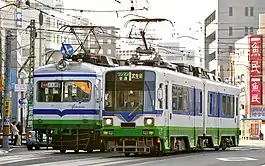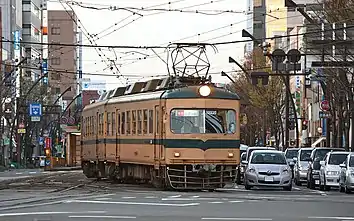Fukui Railway Fukubu Line
The Fukui Railway Fukubu Line (福井鉄道福武線, Fukui Tetsudō Fukubu-sen) is a 21.4 km railway line operated by Fukui Railway in Fukui Prefecture. The line runs from Echizen-Takefu Station in Echizen to Tawaramachi and Fukui-Ekimae stations in Fukui. Although it has its own right-of-way for most of the route, the Fukubu Line runs with traffic as a tram line past Fukui-Shin Station.
| Fukui Railway Fukubu Line | ||||||||||||||||||||||||||||||||||||||||||||||||||||||||||||||||||||||||||||||||||||||||||||||||||||||||||||||||||||||||||||||||||||||||||||||||||||||||||||||||||||||||||||||||||||||||||||||||||||||||||||||||||||||||||||||||||||||||||||||||||||||||||||||||||||||||||||||||||||||
|---|---|---|---|---|---|---|---|---|---|---|---|---|---|---|---|---|---|---|---|---|---|---|---|---|---|---|---|---|---|---|---|---|---|---|---|---|---|---|---|---|---|---|---|---|---|---|---|---|---|---|---|---|---|---|---|---|---|---|---|---|---|---|---|---|---|---|---|---|---|---|---|---|---|---|---|---|---|---|---|---|---|---|---|---|---|---|---|---|---|---|---|---|---|---|---|---|---|---|---|---|---|---|---|---|---|---|---|---|---|---|---|---|---|---|---|---|---|---|---|---|---|---|---|---|---|---|---|---|---|---|---|---|---|---|---|---|---|---|---|---|---|---|---|---|---|---|---|---|---|---|---|---|---|---|---|---|---|---|---|---|---|---|---|---|---|---|---|---|---|---|---|---|---|---|---|---|---|---|---|---|---|---|---|---|---|---|---|---|---|---|---|---|---|---|---|---|---|---|---|---|---|---|---|---|---|---|---|---|---|---|---|---|---|---|---|---|---|---|---|---|---|---|---|---|---|---|---|---|---|---|---|---|---|---|---|---|---|---|---|---|---|---|---|---|---|---|---|---|---|---|---|---|---|---|---|---|---|---|---|---|---|---|---|---|---|---|---|---|---|---|---|---|---|---|---|---|---|---|
 Fukutetsu Series 200 (left) and Series 770 trains near Daimyōmachi intersection | ||||||||||||||||||||||||||||||||||||||||||||||||||||||||||||||||||||||||||||||||||||||||||||||||||||||||||||||||||||||||||||||||||||||||||||||||||||||||||||||||||||||||||||||||||||||||||||||||||||||||||||||||||||||||||||||||||||||||||||||||||||||||||||||||||||||||||||||||||||||
| Overview | ||||||||||||||||||||||||||||||||||||||||||||||||||||||||||||||||||||||||||||||||||||||||||||||||||||||||||||||||||||||||||||||||||||||||||||||||||||||||||||||||||||||||||||||||||||||||||||||||||||||||||||||||||||||||||||||||||||||||||||||||||||||||||||||||||||||||||||||||||||||
| Owner | Fukui Railway | |||||||||||||||||||||||||||||||||||||||||||||||||||||||||||||||||||||||||||||||||||||||||||||||||||||||||||||||||||||||||||||||||||||||||||||||||||||||||||||||||||||||||||||||||||||||||||||||||||||||||||||||||||||||||||||||||||||||||||||||||||||||||||||||||||||||||||||||||||||
| Locale | Fukui Prefecture | |||||||||||||||||||||||||||||||||||||||||||||||||||||||||||||||||||||||||||||||||||||||||||||||||||||||||||||||||||||||||||||||||||||||||||||||||||||||||||||||||||||||||||||||||||||||||||||||||||||||||||||||||||||||||||||||||||||||||||||||||||||||||||||||||||||||||||||||||||||
| Termini | Echizen-Takefu Fukui-Ekimae / Tawaramachi | |||||||||||||||||||||||||||||||||||||||||||||||||||||||||||||||||||||||||||||||||||||||||||||||||||||||||||||||||||||||||||||||||||||||||||||||||||||||||||||||||||||||||||||||||||||||||||||||||||||||||||||||||||||||||||||||||||||||||||||||||||||||||||||||||||||||||||||||||||||
| Stations | 23 | |||||||||||||||||||||||||||||||||||||||||||||||||||||||||||||||||||||||||||||||||||||||||||||||||||||||||||||||||||||||||||||||||||||||||||||||||||||||||||||||||||||||||||||||||||||||||||||||||||||||||||||||||||||||||||||||||||||||||||||||||||||||||||||||||||||||||||||||||||||
| Service | ||||||||||||||||||||||||||||||||||||||||||||||||||||||||||||||||||||||||||||||||||||||||||||||||||||||||||||||||||||||||||||||||||||||||||||||||||||||||||||||||||||||||||||||||||||||||||||||||||||||||||||||||||||||||||||||||||||||||||||||||||||||||||||||||||||||||||||||||||||||
| Type | Heavy rail, Light rail, Interurban | |||||||||||||||||||||||||||||||||||||||||||||||||||||||||||||||||||||||||||||||||||||||||||||||||||||||||||||||||||||||||||||||||||||||||||||||||||||||||||||||||||||||||||||||||||||||||||||||||||||||||||||||||||||||||||||||||||||||||||||||||||||||||||||||||||||||||||||||||||||
| History | ||||||||||||||||||||||||||||||||||||||||||||||||||||||||||||||||||||||||||||||||||||||||||||||||||||||||||||||||||||||||||||||||||||||||||||||||||||||||||||||||||||||||||||||||||||||||||||||||||||||||||||||||||||||||||||||||||||||||||||||||||||||||||||||||||||||||||||||||||||||
| Opened | 1924 | |||||||||||||||||||||||||||||||||||||||||||||||||||||||||||||||||||||||||||||||||||||||||||||||||||||||||||||||||||||||||||||||||||||||||||||||||||||||||||||||||||||||||||||||||||||||||||||||||||||||||||||||||||||||||||||||||||||||||||||||||||||||||||||||||||||||||||||||||||||
| Technical | ||||||||||||||||||||||||||||||||||||||||||||||||||||||||||||||||||||||||||||||||||||||||||||||||||||||||||||||||||||||||||||||||||||||||||||||||||||||||||||||||||||||||||||||||||||||||||||||||||||||||||||||||||||||||||||||||||||||||||||||||||||||||||||||||||||||||||||||||||||||
| Line length | 21.4 km[1] | |||||||||||||||||||||||||||||||||||||||||||||||||||||||||||||||||||||||||||||||||||||||||||||||||||||||||||||||||||||||||||||||||||||||||||||||||||||||||||||||||||||||||||||||||||||||||||||||||||||||||||||||||||||||||||||||||||||||||||||||||||||||||||||||||||||||||||||||||||||
| Track gauge | 1,067 mm (3 ft 6 in) | |||||||||||||||||||||||||||||||||||||||||||||||||||||||||||||||||||||||||||||||||||||||||||||||||||||||||||||||||||||||||||||||||||||||||||||||||||||||||||||||||||||||||||||||||||||||||||||||||||||||||||||||||||||||||||||||||||||||||||||||||||||||||||||||||||||||||||||||||||||
| Electrification | 600 V DC, overhead catenary | |||||||||||||||||||||||||||||||||||||||||||||||||||||||||||||||||||||||||||||||||||||||||||||||||||||||||||||||||||||||||||||||||||||||||||||||||||||||||||||||||||||||||||||||||||||||||||||||||||||||||||||||||||||||||||||||||||||||||||||||||||||||||||||||||||||||||||||||||||||
| Operating speed | 65 km/h[1] 40 km/h on street-running sections | |||||||||||||||||||||||||||||||||||||||||||||||||||||||||||||||||||||||||||||||||||||||||||||||||||||||||||||||||||||||||||||||||||||||||||||||||||||||||||||||||||||||||||||||||||||||||||||||||||||||||||||||||||||||||||||||||||||||||||||||||||||||||||||||||||||||||||||||||||||
| ||||||||||||||||||||||||||||||||||||||||||||||||||||||||||||||||||||||||||||||||||||||||||||||||||||||||||||||||||||||||||||||||||||||||||||||||||||||||||||||||||||||||||||||||||||||||||||||||||||||||||||||||||||||||||||||||||||||||||||||||||||||||||||||||||||||||||||||||||||||
History


The Fukubu Electric Railway (福武電気鉄道, Fukubu Denki Tetsudō) opened the Fukubu Line on 23 February 1924[1] for the purposes of transporting soldiers of the Imperial Japanese Army Sabae 36th Regiment between Takefu-Shin and Heiei (兵営) (now Shinmei) stations.
- 23 February 1924: Fukubu Electric Railway opens the Fukubu Line between Takefu-Shin and Heiei (now Shinmei).[1]
- 26 July 1925: Heiei – Fukui-Shin (now Sekijūjimae) section opens.[1]
- 5 June 1927: Sanjūhassha Station opens.[2]
- 5 October 1927: Mizuochi Station opens;[2] former transfer station for the Seiho Electric Railway.
- 13 August 1929: Kami-Sabae (now Sundome Nishi), Shimo-Sabae (now Nishiyama-Kōen) stations open.
- 15 October 1933: Fukui-Shin – Fukui-Ekimae section opens.
- 1 October 1935: Tobanaka Station opens; Nishi-Tobanaka Station (between Heiei and Tobanaka) closes.[2]
- April 1939: Heiei Station is renamed Chūō Station.
- 1 April 1941: Express service begins.
- 1 August 1945: Fukubu Electric Railway merges with Seiho Electric Railway to form Fukui Railway.[1]
- June 1946: Chūō Station renamed Shinmei Station.
- 12 July 1950: Hanandō – Fukui-Shin section double-tracked.
- 27 November 1950: Honmachi-dōri — Fukui-Shin section opens. Daimyōmachi Station is renamed Honmachi-dōri Station.
- 1 April 1962: Keyamachi Station moved and renamed Kōenguchi Station. Fujishima-Jinja-mae Station (between Kidayotsutsuji and Kōenguchi) closes.[2]
- 11 December 1964: Matsumoto-dōri Station (between Saibanshomae and Tawaramachi) closes. Saibanshomae Station moved towards Tawaramachi.
- 1 September 1969: Service between Hanandō, Fukui-Ekimae, and Tawaramachi abolished; all trains run through to Takefu-Shin Station.
- 2 October 1979: Freight services discontinued.[1]
- 10 April 1980: Centralized traffic control (CTC) introduced.[1]
- 1 August 1985: Driver-only operation introduced on morning and evening services.[1]
- 10 April 1987: Shimo-Sabae Station renamed Nishiyama-Kōen Station.
- 1 October 1989: Hanandō-Minami Station opens.
- 20 January 1993: All trains equipped with ATS.[1]
- 15 April 1993: Hanandō-Minami Station renamed Bell-mae Station.
- 20 September 1997: Harmony Hall Station opens.
- 30 November 1998: Daytime service interval changed to 20 minutes.[1]
- 15 July 2002: Honmachi-dōri Station (between Kōenguchi and Shiyakushomae) closed.
- 1 December 2003: Part of Shiyakushomae — Fukui-Ekimae section single-tracked due to construction around Fukui Station.
- 30 September 2004: Semi-express service abolished.
- January–March 2006: All station platforms modified to serve low-floor vehicles.
- 1 April 2006: Low-floor trains enter service. Last departure time brought forward 30 minutes.
- 16 December 2007: Daytime shuttle trains begin service between Fukui-Ekimae and Tawaramachi.
On March 25, 2010, Sports-Kōen Station was established between the Nishi-Takefu and Iehisa stations. At the same time, five stations were renamed: Takefu-Shin to Echizen-Takefu; Nishi-Takefu to Kitago; Kami-Sabae to Sundome-Nishi; Fukui-Shin to Sekijūjimae; and Saibanshomae to Jin'ai-Joshikōkō.[3][4]
Station list
- All stations are located in Fukui Prefecture.
- Express (急行) trains stop at stations marked "●", pass those marked "|", and only a few stop at those marked "○". Most local trains stop at all stations but some pass those marked "○".
- Staff:
- ◎ - Present all day
- ○ - Present except early mornings and late nights
- ◇ - Present during peak hours only
- △ - Present during holidays only
- × - Unstaffed
- ※ - Present during events only
| Station | Japanese | Distance (km) | Express | Staff | Transfers | Location | |
|---|---|---|---|---|---|---|---|
| Between Stations |
Total | ||||||
| Echizen-Takefu | 越前武生 | - | 0.0 | ● | ◎ | West Japan Railway Company (JR West): Hokuriku Main Line (Takefu) | Echizen |
| Kitago | 北府 | 0.6 | 0.6 | ● | × | ||
| Sports Kōen | スポーツ公園 | 1.1 | 1.7 | | | × | ||
| Iehisa | 家久 | 0.7 | 2.4 | ● | × | ||
| Sundome Nishi | サンドーム西 | 1.7 | 4.1 | | | × | Sabae | |
| Nishi-Sabae | 西鯖江 | 1.2 | 5.3 | ● | ○ | ||
| Nishiyama-Kōen | 西山公園 | 0.7 | 6.0 | | | ※ | ||
| Mizuochi | 水落 | 1.3 | 7.3 | ● | × | ||
| Shinmei | 神明 | 1.2 | 8.5 | ● | ○ | ||
| Tobanaka | 鳥羽中 | 1.2 | 9.7 | | | × | ||
| Sanjūhassha | 三十八社 | 1.2 | 10.9 | | | × | Fukui | |
| Taichō no Sato | 泰澄の里 | 1.3 | 12.2 | | | × | ||
| Asōzu | 浅水 | 0.8 | 13.0 | ● | ○ | ||
| Harmony Hall | ハーモニーホール | 0.8 | 13.8 | | | × | ||
| Seimei | 清明 | 1.1 | 14.9 | | | × | ||
| Ebata | 江端 | 0.6 | 15.5 | | | × | ||
| Bell-mae | ベル前 | 0.6 | 16.1 | ● | △ | ||
| Hanandō | 花堂 | 0.8 | 16.9 | | | × | ||
| Sekijūjimae | 赤十字前 | 0.9 | 17.8 | ● | ○ | ||
| Shokokaigishomae | 商工会議所前 | 0.6 | 18.4 | ● | × | ||
| Asuwayamakoenguchi | 足羽山公園口 | 0.5 | 18.9 | ● | × | ||
| Fukui Castle Ruins-daimyomachi | 福井城址大名町 | 0.7 | 19.6 | ● | ◇ | ||
| Fukui-eki | 福井駅 | 0.5 | 20.1 | ○ | × | JR West: Hokuriku Main Line (Fukui) Echizen Railway: Katsuyama Eiheiji Line (Fukui) | |
| Jin'ai Joshikōkō | 仁愛女子高校 | 0.6* | 20.2 | ● | × | ||
| Tawaramachi | 田原町 | 0.7 | 20.9 | ● | × | Echizen Railway: Mikuni Awara Line (Some through to Washizuka-Haribara) | |
- Note that distances for Jin'ai Joshikōkō and Tawaramachi Stations are measured from Shiyakushomae Station.[1]
References
- Terada, Hirokazu (July 2002). データブック日本の私鉄 (Databook: Japan's Private Railways). Japan: Neko Publishing. ISBN 4-87366-874-3.
- 今井恵介監修『日本鉄道旅行地図 6号 北信越』新潮社、2008年、p.25
- 福武線に新駅「スポーツ公園駅」 来月25日開業--今年3月 /福井 Archived 2010-02-21 at the Wayback Machine Fukui Shimbun, February 19, 2010. (in Japanese)
- 平成22年3月25日 ダイヤ改正! Fukui Railway. (in Japanese)
External links
- Fukui Railway (in Japanese)